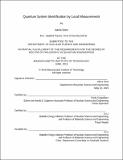Quantum system identification by local measurements
Author(s)
Sone, Akira,Ph. D.Massachusetts Institute of Technology.
Download1134982674-MIT.pdf (3.805Mb)
Other Contributors
Massachusetts Institute of Technology. Department of Nuclear Science and Engineering.
Advisor
Paola Cappellaro.
Terms of use
Metadata
Show full item recordAbstract
Quantum information processing, including quantum computation, quantum communication, and quantum metrology, is expected to be the next-generation information technology capable of outperforming classical devices. The physical platform for quantum information devices requires many-body quantum systems with many interacting qubits (two-level systems), and several experimental systems have been actively studied in recent years for realizing such scalable quantum information processors. Reliable quantum information processing essentially requires robust initialization of the quantum system, robust control protocols and precise measurement. As these indispensable tasks strongly depend on the physical properties and dynamics of the quantum system, the precise characterization of the experimental system, namely quantum system identification, is a crucial prerequisite. In a closed quantum system, the Hamiltonian includes the information about the properties of the system, such as the number of qubits, single-body energy of qubits, topology of qubit network graph and coupling types between qubits. For thermal equilibrium state, the temperature also becomes an important parameter characterizing the thermal properties of the system. Quantum system identification aims at extracting these elements from measurements of the system dynamics or state. However, performing measurement over the whole many-qubit system is typically a demanding task in the laboratory. Furthermore, given the lack of knowledge about the system, one cannot control or measure the system with high accuracy before characterizing it. Thanks to recent advances in quantum metrology with a single qubit sensor, a well-characterized qubit system can play the role of a quantum probe, which is coherently coupled to the target system, thus enabling practical schemes to identify the target many-body quantum system indirectly through system-probe correlations. More broadly, this quantum probe strategy is an example of system identification performed via local measurements. This thesis focuses on the role of quantum correlations in quantum system identification assisted by local measurements in two different regimes: (1) dynamical and (2) equilibrium regime. In the dynamical regime, we introduce the mathematical concept of quantum system identifiability with respect to Hamiltonian parameter identification and Hilbert space dimension identification. Exploiting the linearity of the dynamics, we employ linear system realization theory, algebraic geometry and graph-theory to analyze the identifiability of an unknown Hamiltonian or the dimensions of the Hilbert space of the target many-body quantum system. Based on the formalism, we propose practical algorithms for both identifiability problems. We further find that propagation of correlations between the quantum probe and the whole system is a necessary condition to fully identify the parameters and dimensions of the target system through local measurements on the quantum probe. In the equilibrium regime, the thesis discusses the problem of estimating either the temperature or Hamiltonian parameters, which can in general be extracted by characterizing the thermal equilibrium state. We discuss a general local measurement scheme, which we call "greedy local measurement scheme", where one performs sequential optimal measurement on a complete set of subsystems. We introduce a practical measure of nonclassical correlations, called discord for local metrology, to measure the nonclassical correlations induced by local optimal measurements. By comparing the greedy local measurement scheme and global measurement scheme, we explicitly demonstrate that in the high-temperature limit discord for local metrology quantifies the ultimate precision limit loss in local metrology. Conversely, this shows that nonclassical correlations could contribute to sensitivity enhancement in parameter estimation even at thermal equilibrium. These results can be expected to contribute to the characterization of near-term quantum information processors, such as Noisy Intermediate-Scale Quantum (NISQ) devices, and to find applications in quantum sensing, e.g. in room-temperature nanoscale magnetic resonance sensing of nuclear spins in molecules or imaging of biological complex systems.
Description
This electronic version was submitted by the student author. The certified thesis is available in the Institute Archives and Special Collections. Thesis: Ph. D., Massachusetts Institute of Technology, Department of Nuclear Science and Engineering, 2019 Cataloged from student-submitted PDF version of thesis. Includes bibliographical references (pages 149-165).
Date issued
2019Department
Massachusetts Institute of Technology. Department of Nuclear Science and EngineeringPublisher
Massachusetts Institute of Technology
Keywords
Nuclear Science and Engineering.